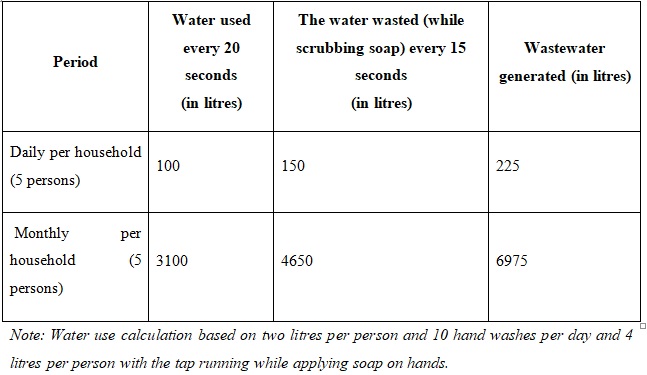INTRODUCTION
Water is a primary need, and in a Covid-19 situation, it assumes a significant role in ensuring recommended hygiene protocols related to hand wash and clean drinking water. This will create extra demand for water and put pressure on the already scarce availability. The impact of COVID-19 can be seen on Sustainable Development goals also there is an indirect link between Covid-19 and Sustainable Development Goals. This is what the 2030 Agenda for Sustainable Development, the global blueprint to end poverty, protect our planet and ensure prosperity is about. The agenda, adopted by all United Nations Member States in 2015, are 17 Sustainable Development Goals (SDGs), the majority of which are interconnected. THE sixth SDG is to ensure access to water and sanitation for all. While significant progress has been made in increasing access to clean drinking water and sanitation, billions of people—mostly in rural areas—still lack these basic services. Given the existing pandemic, the fate of SDG 6, “Ensure Availability and Sustainable Management of Water and Sanitation for All” becomes more critical.
II. Methodology
In order to accomplish the task analytical and historical methods has been used. Data collected through both the primary and the secondary sources will be systematized, analyzed and interpreted on the basic premise of the research topic.
III. Objectives
1) To identify the impact of COVID19 on SDG 6 special reference to water.
2) To identify some suggestions and measures to overcome the risk of water scarcity.
IV. Discussion
About 600 million Indians face acute water shortages and about 160 million people don’t have access to clean water. The need for well-organized water management agenda for post-Covid-19 reform. As per Sustainable Development Goals Report (2019), 2 out of 5 people globally do not have a basic handwashing facility with soap and water at home by 2030, 700 million could be displaced by intense water scarcity. Many countries in South and South-East Asia are suffering from water crisis and do not have access to safe drinking water and sanitation.
The goal is divided into six targets:
SDG 6.1: Achieve universal and equitable access to safe and affordable drinking water for all. Today, the only safeguard against the pandemic is that we wash our hands frequently — 20 seconds each time. Clean water remains the most important preventive health measure in the world. Washing hands with soap and water is one of the best ways to remove the novel coronavirus (SARS-CoV-2). The homeless and the thousands of urban poor who live in slums across major cities and towns, to maintain good hygiene. A proper hand wash needs lathering soap and scrubbing hands on both sides for at least 20 seconds, according to WHO guidelines. A family of five members would thus need 100 to 200 litres of water per day only to wash hands. This would result in the generation of around 200 litres of wastewater per day, a 20 to 25 per
cent increase in water demand & the generation of wastewater from human
settlements.
Estimated water usage in five-person household
 Lack of clean water affects vulnerability to disease and ill health. The need of the hour is also to establish a commonly agreed method for assessing affordability, as payment for services should not be a barrier to accessing services. In countries where water resources are limited, the governments should work on the existing water paradigm.
Lack of clean water affects vulnerability to disease and ill health. The need of the hour is also to establish a commonly agreed method for assessing affordability, as payment for services should not be a barrier to accessing services. In countries where water resources are limited, the governments should work on the existing water paradigm.
SDG 6.2: Achieve access to adequate and equitable sanitation and hygiene for all and end open defecation, paying special attention to the needs of women and girls and those in vulnerable situations.
It calls for countries to end open defecation, to ensure that everyone has access to a basic toilet and to put in place systems for the safe management of excreta. Better sanitation is considered
to be one of the key elements in the management of COVID-19 spread.
SDG 6.3: By 2030, improve water quality by reducing pollution, eliminating dumping and minimising release of hazardous chemicals and materials, halving the proportion of untreated wastewater and substantially increasing recycling and safe reuse globally.
With the worldwide lockdown, water bodies are receiving the least industrial hazardous and solid waste. As an outcome of this, the quality of water in rivers and lakes has partly improved. However, this is a temporary solution and calls the decision-makers to revisit our planning approach of cleaning water bodies. There is a need to have a combination of approaches, sewage treatment plants (STPs), effluent treatment plants (ETPs) and decentralized wastewater / solid waste treatment systems which will treat the household and industrial waste before incoming the water body, thus enduring less pollution.
SDG 6.4: Substantially increase water-use efficiency across all sectors and ensure sustainable withdrawals and supply of freshwater to address water scarcity and substantially reduce the number of people suffering from water scarcity.
COVID-19 has brought to the attention the need to be water prudent and water-wise to tackle water scarcity. Awareness and mindset changes are required to use water efficiently.
SDG 6.5: Implement integrated water resources management at all levels, including through transboundary cooperation as appropriate.
Sufficient integrated water resource management is one of the most powerful tools to ensure the supply of drinking water and wastewater treatment. The role of integrated urban water management (IUWM), integrating water supply and demand, wastewater management, stormwater, etc., has been suggested as a way out to sustainable water management by several researchers.
SDG 6.6: By 2020, protect and restore water-related ecosystems, including mountains, forests, wetlands, rivers, aquifers and lakes.
The effect of climate change on the ecosystem cannot be ignored, instances of frequent floods and droughts is the new normal and to top it all, recent forest fires in the USA and Australia are observe to the effects of climate change.
On March 31, 2020, the UN Secretary-General announced the establishment of a COVID-19 Response and Recovery Fund. This multi-donor trust fund aims to raise $1 billion this year and one of the aims is to safeguard the SDG programmes from COVID-19-induced setbacks. It has also called for a $2.5 trillion coronavirus crisis package for developing countries. This is an excellent initiate, but there is a lot more to be done to enable the developing countries to achieve their SDGs, particularly in the areas of water and sanitation for all.
V. Suggestions
To overcome the risk of water scarcity integrating water resource management measures are required in order to minimize the water scarcity risks.
• Required more financial and technical support and increased knowledge to fulfil their SDGs on water and sanitation for all.
• Each citizen wants to be careful in the use of water, as a society we need to be water-wise, every drop of water counts. The current conditions provide an opportunity to promote the idea of maintaining hygiene as it is imperative now and should be encouraged in the future too.
• Reduce, Reuse, Recycle, and Recover are the guidelines and help us to manage and preserve our resources. To lead a lifestyle that is more focused on resource management and more sustainable, new words are added. Approaches like 7’R (Reduce, Reuse, Recycle, Recover, Recharge, Rethink, and Rejuvenate) which gives a holistic view to conserve water should be incorporated in our water management plans. Such an approach gives us a wider lens to think and help us to preserve water in every possible way.
VI. Conclusion
The impact of COVID-19 is visible in every sector and the effect of Covid-19 can be seen on Sustainable Development goals also there is an indirect link between Covid-19 and Sustainable Development Goals. SDG 6 is to ensure access to water and sanitation for all is affected badly. At present, the world is being asked to wash hands multiple times a day. Moreover, billions of people lack safe water sanitation, and funding is inadequate. Therefore the need for time is to plans to overcome this risk of water scarcity. Integrating water resource management measures are necessary in order to minimize the water scarcity risks.
 Author Details: Tegbir Kaur is a Research Scholar at the Department of Political Science, the Rajiv Gandhi National University of Law, Patiala, Punjab, India
Author Details: Tegbir Kaur is a Research Scholar at the Department of Political Science, the Rajiv Gandhi National University of Law, Patiala, Punjab, India 
